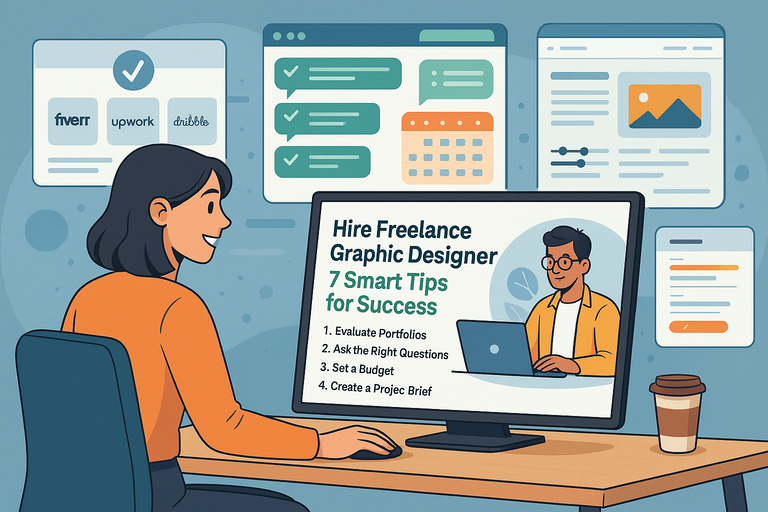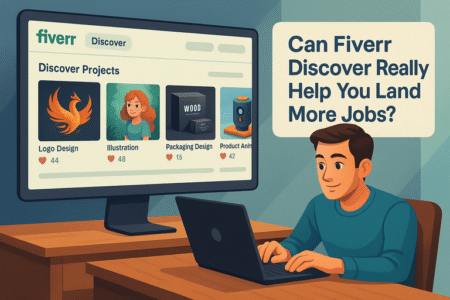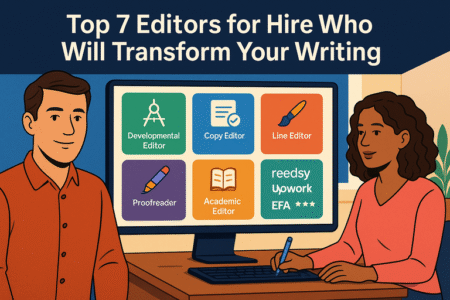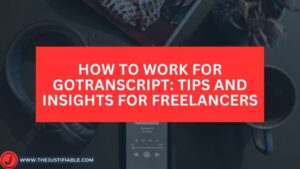Table of Contents
Hire freelance graphic designer wisely, and you’ll unlock creative talent without draining your budget. But how do you make sure you actually get the results you want instead of dealing with endless revisions, missed deadlines, or mismatched styles?
This guide will walk you through seven proven tips that will help you hire the right designer, set clear expectations, and make your project a success.
1. Define Your Design Needs Before You Hire
If you want to hire a freelance graphic designer successfully, the very first step is figuring out what you actually need. This may sound obvious, but I’ve seen many projects go sideways because expectations weren’t clear from the start.
Think of it like ordering at a restaurant: If you just say, “I want food,” you could end up with sushi when you were craving pizza. The same goes for design — clarity saves you time, money, and stress.
Clarify The Purpose Of Your Project
Ask yourself: Why do I need this design? Is it to increase sales, boost brand awareness, or make your website look more professional? When you define the purpose, you’ll be able to guide your designer toward decisions that align with your goals.
For example, if your goal is to sell more products through social media, you’ll need a designer who knows how to create scroll-stopping graphics optimized for Instagram and TikTok.
On the other hand, if your goal is to build trust with B2B clients, you may need polished corporate materials like pitch decks, reports, or branded templates.
I recommend writing down a single sentence mission for your project, like: “I need a social media ad campaign that attracts more sign-ups for my webinar.” That simple statement gives your designer a compass to follow.
Decide On The Specific Deliverables You Require
One of the most common mistakes I see is vague requests like “I need a logo” or “I need some graphics.” A logo for what? Graphics for which platform? Being too broad forces your designer to guess, which usually leads to disappointment.
Here’s a quick way to structure deliverables:
- Logo design: Main logo, icon version, and horizontal/vertical layouts.
- Social media posts: Templates for Instagram (1080×1080), Stories (1080×1920), and LinkedIn banners (1584×396).
- Website assets: Homepage hero image, call-to-action buttons, blog feature images.
I advise making a list with formats, sizes, and platforms. Many designers will thank you for this level of detail, and you’ll avoid the dreaded “Can you resize this?” conversation two weeks after delivery.
Understand The Style And Branding You Want
Design is subjective — what looks bold and modern to you might look loud and unprofessional to someone else. This is why style alignment is critical.
Start with inspiration. Collect 4–5 examples of designs you like (Pinterest boards, Behance projects, even screenshots from competitors). Share them with your designer along with notes like, “I love the clean typography in this one” or “This color scheme feels too dark for our brand.”
If your brand already has guidelines, provide them upfront. Things like HEX codes, fonts, or do’s and don’ts save hours of back-and-forth. And if you don’t have brand guidelines yet, this might be the perfect time to ask your freelance designer to help create a starter version for you.
2. Research The Right Platforms To Find Freelancers
Once you know exactly what you need, the next challenge is finding the right person to bring your vision to life. The internet is full of talented designers, but it’s also full of noise. Choosing where to look is just as important as choosing who to hire.
Explore Reputable Freelance Marketplaces
Freelance platforms are usually the first stop for most people, and for good reason: they make it easy to compare designers, review portfolios, and check ratings before you commit.
Popular choices include:
- Upwork: Great for long-term projects with its time-tracking and contract tools.
- Fiverr Pro: Useful if you want to hire quickly for smaller design tasks. The “Pro” tier vets designers for quality.
- Freelancer.com: Allows you to post a project and receive bids, which can give you a wide range of pricing options.
I suggest looking beyond the star rating. Check the number of completed projects, feedback from past clients, and whether their portfolio matches your style.
Remember: A 5-star rating from doing dozens of $5 logos doesn’t always translate into the ability to design a professional rebrand.
Consider Specialized Design Communities
If you want top-tier design talent, sometimes general freelance marketplaces aren’t enough. Specialized platforms and communities attract designers who are deeply invested in their craft.
- Dribbble: Designers showcase creative shots of their work. Their “Hire Designers” section lets you filter by skills like UI design, branding, or motion graphics.
- Behance: A portfolio-driven site owned by Adobe where you can explore complete projects and contact designers directly.
- 99designs: Works on a contest model — you set a brief, multiple designers submit concepts, and you pick your favorite.
These communities often give you more creative inspiration because you can see how designers think and present their work, not just finished files. In my experience, this makes it easier to spot creativity that fits your brand personality.
Compare The Pros And Cons Of Agencies vs. Freelancers
This is where a lot of people get stuck: should you hire an individual freelancer or go with a design agency? Both options have clear strengths, and the right choice depends on your needs.
Freelancers
- Usually more affordable.
- Direct communication with the person doing the work.
- Flexible and quick to adapt.
- May have limited bandwidth if your project is large or ongoing.
Agencies
- Access to a team of designers, copywriters, and strategists.
- More structured processes and consistent delivery.
- Can handle large, complex projects with multiple assets.
- Higher cost due to overhead.
If you’re a small business looking for one-off designs or branding help, I believe freelancers are usually the smarter choice. If you’re running a company that needs dozens of deliverables every month across different formats, an agency might be worth the investment.
3. Evaluate Portfolios With A Critical Eye
Before you hire a freelance graphic designer, you need to dig into their portfolio. A portfolio isn’t just a gallery of pretty pictures; it’s a window into how that designer thinks, solves problems, and expresses creativity. The trick is knowing what to look for beyond surface-level aesthetics.
Look For Versatility And Range In Work Samples
A strong portfolio usually shows variety. You want to see how a designer adapts across different mediums: Logos, social media ads, packaging, or full branding systems.
Here’s what I do when reviewing:
- Check if the designer has worked with businesses in different industries. A logo for a coffee shop should feel different than a corporate law firm.
- Notice if they’ve used different styles — bold and edgy, minimal and clean, playful and colorful. That range proves adaptability.
- Pay attention to whether they’ve designed for both digital and print formats. A Facebook ad and a brochure require different skills.
Versatility is important because you may hire them for one project today, but your needs could grow. If they’ve shown they can flex creatively, you won’t have to start from scratch with someone new later.
Check Consistency And Quality Of Past Projects
While variety is good, quality matters more. Every piece in their portfolio should look polished and intentional. Sloppy typography, pixelated graphics, or clashing colors are red flags.
I also suggest checking for consistency within a single project. For example, if you’re looking at a brand identity package, does the logo, color palette, and marketing collateral all feel cohesive? That shows attention to detail.
Another tip: don’t be blinded by one or two flashy designs. Look at the portfolio as a whole. A designer who consistently produces strong work is far more reliable than one who just got lucky with one project.
Match Their Style To Your Brand Identity
Even the most talented designer won’t be a good fit if their style clashes with your brand. Imagine hiring a designer known for grunge, graffiti-inspired work to create a minimalist brand identity for a wellness spa — it’s a mismatch waiting to happen.
I recommend this simple test: put their portfolio side-by-side with your brand’s existing materials or inspiration board. Ask yourself: do they align? Can I see my brand living in the same design language?
If you’re unsure, reach out to the designer and ask for a mock-up or a quick style exploration (many freelancers will do this for a small fee). It’s better to spend a little upfront than invest heavily in a design that doesn’t reflect who you are.
4. Ask The Right Questions During Interviews
Once you’ve found a designer with a promising portfolio, the interview is your chance to dig deeper. This isn’t just about confirming skills — it’s about making sure they’ll be a good working partner. The right questions can save you weeks of frustration later.
Discuss Their Creative Process In Detail
Every designer has a different workflow, and you need to know if it matches your expectations. Ask them to walk you through a typical project step by step.
For example, they might say:
- Start with research and inspiration gathering.
- Share initial sketches or concepts for feedback.
- Refine the strongest option into a polished design.
- Deliver final files in the requested formats.
This kind of transparency helps you understand what to expect. If they can’t explain their process clearly, that’s usually a sign they don’t have one — and you’ll end up micromanaging.
I always suggest asking, “What do you need from me to do your best work?” A good designer will ask for things like brand guidelines, inspiration boards, or a clear brief. If they say, “Just tell me what you want,” that’s too vague.
Understand How They Handle Feedback And Revisions
Design is rarely perfect on the first try. Revisions are part of the process, but how a designer approaches feedback makes all the difference.
Ask questions like:
- How many revision rounds are included in your fee?
- What’s your preferred way to receive feedback — email, annotated PDFs, or live calls?
- Can you share an example of a project where feedback changed the direction?
The answers will reveal a lot about their flexibility and communication style. In my experience, the best designers welcome constructive feedback and don’t take it personally. The ones who get defensive or dismissive? They’re trouble down the road.
Clarify Availability And Time Management Skills
Creative talent is only useful if it’s delivered on time. Freelancers juggle multiple clients, so you need to know where you fit in their schedule.
I recommend asking:
- What’s your typical turnaround time for a logo, social media package, or full brand identity?
- How many clients do you usually take on at once?
- What’s your process if you hit an unexpected delay?
A reliable designer will give clear answers and set realistic expectations. If someone promises to deliver a complex rebrand in three days, that’s a red flag.
You can also test their time management by setting a small, paid trial project. See if they meet the deadline and communicate proactively. If they nail the small task, you can feel confident about trusting them with larger projects.
5. Set A Realistic Budget And Payment Terms
Money conversations can feel awkward, but they’re essential if you want to hire a freelance graphic designer successfully. Setting a realistic budget upfront prevents misunderstandings and ensures both you and the designer feel valued.
Learn What Influences Freelance Rates
Freelance rates aren’t pulled out of thin air. They depend on a few key factors:
- Experience level: A designer with 10 years of branding work will charge more than someone just starting out.
- Type of project: A simple banner ad takes less time than a complete visual identity system.
- Turnaround speed: Rush jobs almost always cost extra.
- Location: Designers in big cities or high-cost countries often price higher than those in smaller markets.
From what I’ve seen, junior designers might charge $25–$50 an hour, while seasoned brand specialists can easily ask $100–$150 an hour or more. Don’t just chase the lowest rate — think about the value the designer brings to your business.
Decide Between Hourly And Fixed-Rate Projects
Both payment models have pros and cons. Choosing the right one depends on the scope and clarity of your project.
- Hourly: Best when the project is open-ended or you expect ongoing collaboration. You’ll pay for actual time spent, but costs can add up if you’re not careful.
- Fixed-rate: Ideal when you know exactly what you need (e.g., a logo, 5 social media templates, and a business card design). It gives you a clear budget from the start.
Personally, I suggest fixed-rate pricing for one-off projects. It keeps everyone aligned and avoids the “surprise” invoice at the end. Hourly makes sense if you’re hiring someone for long-term design support.
Protect Yourself With Secure Payment Platforms
Trust is important, but protection matters too. If you’re working with a freelancer you’ve never hired before, use secure payment platforms.
- Upwork or Fiverr Pro: Both hold funds in escrow until work is approved.
- PayPal Business: Offers buyer protection, but make sure you send payments as “Goods and Services,” not “Friends and Family.”
- Contracts + Deposits: If paying directly, always use a written agreement and pay a deposit (usually 30–50%) before work begins.
I advise avoiding full upfront payments unless you already have an established relationship with the designer. Paying in stages tied to milestones protects both sides.
6. Create A Clear And Detailed Project Brief
Once the budget is set, your next task is creating a project brief. A good brief is like GPS for your designer — it tells them where to go without constant detours. The more detailed it is, the smoother your project will run.
Include Brand Guidelines And Visual References
Designers aren’t mind readers. If you already have brand guidelines, share them upfront. These usually include:
- Logo variations and correct usage.
- Color palettes with HEX or RGB codes.
- Typography rules (fonts, sizes, spacing).
- Brand tone or personality notes.
If you don’t have formal guidelines, at least provide visual references. Tools like Pinterest or a simple Google Doc with screenshots can go a long way.
For example: “I love the clean layout of this Nike campaign” or “This color scheme feels too muted for my audience.”
Define Deadlines And Project Milestones
Deadlines keep projects from drifting endlessly. Instead of saying “I need this in two weeks,” break it into milestones:
- Day 3: First draft or rough concept.
- Day 7: Revised draft after feedback.
- Day 14: Final polished files.
Milestones help you catch issues early. They also give your designer breathing room to refine ideas instead of cramming everything at the last minute.
Establish How Communication Will Work
Clear communication avoids endless email chains and misaligned expectations. Decide upfront how and where you’ll collaborate:
- Slack or Microsoft Teams: Great for quick updates.
- Trello or Asana: Helps track tasks, revisions, and deadlines.
- Zoom or Google Meet: Useful for walking through revisions live.
I suggest setting a weekly check-in point. Even a short 10-minute update call can save hours of confusion later.
7. Build Long-Term Relationships With Designers
Hiring a freelance graphic designer isn’t just about one project. The real magic happens when you build a long-term partnership. A designer who understands your brand deeply will deliver faster, better, and more consistently over time.
Provide Constructive Feedback For Improvement
Design is a two-way street. Instead of saying “I don’t like it,” explain why: “This font feels too formal for my younger audience.” Clear, actionable feedback helps designers improve and strengthens your collaboration.
I’ve found that giving feedback in context works best. For example, instead of writing vague comments in an email, try annotating directly on a PDF or using collaboration tools like Figma, where you can pin comments to exact design elements.
Recognize And Reward Good Work
Freelancers thrive on positive relationships just like employees do. A simple “This design nailed exactly what I had in mind” goes a long way.
If you’re thrilled with their work, go a step further:
- Offer a testimonial they can add to their portfolio.
- Refer them to other businesses.
- Send a small bonus if the work exceeded expectations.
These gestures don’t just make you a “nice client.” They also move you to the top of the freelancer’s priority list for future projects.
Rehire Trusted Designers For Future Projects
One-off projects are fine, but long-term collaboration is where the real value is. A designer who knows your brand inside and out won’t need to start from scratch each time. That saves you both time and money.
I suggest creating a “preferred partners” list of freelancers you trust. For example, you might have one go-to designer for branding, another for social media graphics, and another for motion design.
Over time, they become an extension of your team — without the overhead of full-time hires.






